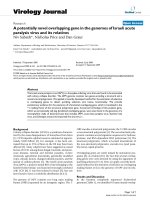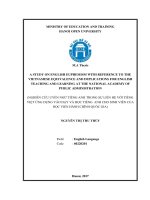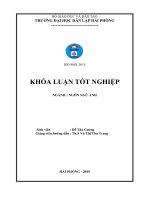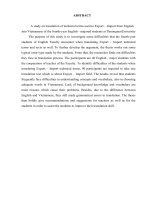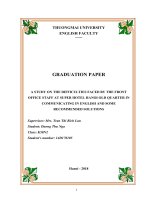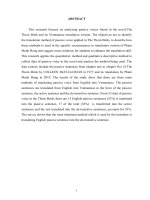A study on translation equivalence between some poems of prison diary (vietnamese version) and its english translation by aileen palmer on form based approach of mona baker (1992)
Bạn đang xem bản rút gọn của tài liệu. Xem và tải ngay bản đầy đủ của tài liệu tại đây (904.83 KB, 112 trang )
VIETNAM NATIONAL UNIVERSITY, HANOI
UNIVERSITY OF LANGUAGES AND INTERNATIONAL STUDIES
FACULTY OF POST-GRADUATE STUDIES
LÊ THỊ NHUNG
A STUDY ON TRANSLATION EQUIVALENCE BETWEEN SOME POEMS
OF PRISON DIARY (VIETNAMESE VERSION) AND ITS ENGLISH
TRANSLATION BY AILEEN PALMER ON FORM-BASED APPROACH
OF MONA BAKER (1992)
NGHIÊN CỨU TƢƠNG ĐƢƠNG DỊCH THUẬT GIỮA MỘT SỐ BÀI THƠ
NHẬT KÝ TRONG TÙ ( BẢN TIẾNG VIỆT) VÀ BẢN DỊCH TIẾNG ANH
TƢƠNG ỨNG CỦA AILEEN PALMER THEO QUAN ĐIỂM CỦA MONA
BAKER (1992)
M.A. COMBINED PROGRAMME THESIS
Field: English Linguistics
Code: 60220201
Hanoi - 2016
VIETNAM NATIONAL UNIVERSITY, HANOI
UNIVERSITY OF LANGUAGES AND INTERNATIONAL STUDIES
FACULTY OF POST-GRADUATE STUDIES
LÊ THỊ NHUNG
A STUDY ON TRANSLATION EQUIVALENCE BETWEEN SOME POEMS
OF PRISON DIARY (VIETNAMESE VERSION) AND ITS ENGLISH
TRANSLATION BY AILEEN PALMER ON FORM-BASED APPROACH
OF MONA BAKER (1992)
NGHIÊN CỨU TƢƠNG ĐƢƠNG DỊCH THUẬT GIỮA MỘT SỐ BÀI THƠ
NHẬT KÝ TRONG TÙ ( BẢN TIẾNG VIỆT) VÀ BẢN DỊCH TIẾNG ANH
TƢƠNG ỨNG CỦA AILEEN PALMER THEO QUAN ĐIỂM CỦA MONA
BAKER (1992)
M.A. COMBINED PROGRAMME THESIS
Field: English Linguistics
Code: 60220201
Supervisor: Assoc.Prof. Dr. Nguyễn Xuân Thơm
Hanoi - 2016
DECLARATION
I, the undersigned, hereby certify my authority of the study project report
entitled “A study on translation equivalence between some poems of Prison Diary
(Vietnamese version) and its English translation by Aileen Palmer on form-based
approach of Mona Baker (1992)” submitted in partial fulfillment of the
requirements for the degree of Master in English Linguistics. Except where the
reference is indicated, no other person‘s work has been used without due
acknowledgement in the text of the thesis.
Hanoi, 2016
Lê Thị Nhung
i
ACKNOWLEDGEMENTS
This thesis could not have been completed without the help and support from
a number of people.
First and foremost, I would like to express my sincere gratitude to Assoc. Prof.
Dr. Nguyen Xuan Thom, my supervisor, who has patiently and constantly supported
me through the stages of the study, and whose stimulating ideas, expertise, and
suggestions have inspired me greatly through my growth as an academic researcher.
A special word of thanks goes to Assoc. Prof. Dr. Le Hung Tien; without his
interesting lectures on Research Methodology in Applied Linguistics and
Translation Studies, consultancy and encouragement, it would never have been
possible for me to have this thesis accomplished.
Last but not least, I am greatly indebted to my family for the endless sacrifice
they have devoted to the fulfillment of this academic work.
ii
ABSTRACT
Given that translation equivalence lies at the center of what translation is
and the translation of Prison Diary has posed both interests and challenges, the
researcher conducted a study, investigating types of form-based equivalence
proposed by Mona Baker (1992) between thirty Prison Diary poems and theirs
translated versions by Aileen Palmer as well as some obstacles encountered by the
translator. Pairs of data were compared, contrasted and interpreted into different
categories. Three prevalent types of non-equivalence have been identified, including
that at the level of word, above word, and grammatically upon careful collection
and interpretative analyses of data from both source texts and target texts. In
coupled with the existence of such non-equivalence, many obstacles were addressed
by the translator due to gaps in both linguistic and literary terms. The paper also
sheds some light on practical applications for translators, and teachers and students
with their work of translation.
iii
TABLE OF CONTENTS
DECLARATION
i
ACKNOWLEDGEMENTS
ii
ABSTRACT
iii
TABLE OF CONTENTS
LIST OF ABBREVIATIONS
iv
vi
PART A : INTRODUCTION ...................................................................................1
1. RATIONALE...........................................................................................................1
2. AIMS OF THE STUDY .............................................................................................2
3. SCOPE OF THE STUDY ...........................................................................................3
4. SIGNIFICANCE OF THE STUDY ...............................................................................3
5. RESEARCH METHODOLOGY ..................................................................................4
5.1. Research questions and concepts ..................................................................4
5.2. Research approach (Theoretical framework) ...............................................5
5.3. Research methods (analytical framework) ....................................................5
6. DESIGN OF THE STUDY..........................................................................................6
PART B : DEVELOPMENT....................................................................................8
CHAPTER 1 : LITERATURE REVIEW ...............................................................8
1.1.TRANSLATION THEORY ......................................................................................8
1.1.1. Definition of translation .............................................................................8
1.1.2. Translation equivalence ...........................................................................11
1.2. MONA BAKER‘S THEORY ON EQUIVALENCE ...................................................24
1.2.1. Equivalence at word level ........................................................................24
1.2.2. Non-equivalence at word level .................................................................26
1.2.3.Equivalence above word level ...................................................................37
1.2.4. Grammatical equivalence.........................................................................44
1.2.5. Textual equivalence ..................................................................................47
1.2.6. Pragmatic equivalence .............................................................................52
1.3. LITERARY TRANSLATION .................................................................................57
1.3.1. Literary translation ..................................................................................57
1.3.2. Some problems in literary translation ......................................................58
1.3.3. Features of poetic translation and language ...........................................58
iv
1.4. PREVIOUS STUDIES ON TRANSTION EQUIVALENCE IN LITERARY WORKS ........62
CHAPTER 2: RESEARCH METHODOLOGY .................................................65
2.1. AIMS AND OBJECTIVES OF THE STUDY.............................................................65
2.1.1. Aims ..........................................................................................................65
2.1.2. Objectives .................................................................................................65
2.2. RESEARCH DESIGN AND PROCEDURES .............................................................66
2.2.1. Research design ........................................................................................66
2.2.2. Research procedures ( procedural framework) .......................................66
2.3. RESEARCH METHODS .......................................................................................67
2.3.1. Subjects of study .......................................................................................67
2.3.2. Data collection and description ...............................................................67
2.3.3 Data analysis (discovery – phenomenon – analysis and
evaluation/explanation) ......................................................................................68
CHAPTER 3 : FINDINGS AND DISCUSSION ..................................................70
3.1. TRANSLATION (NON)EQUIVALENCE AND THE MOST POPULAR ONE ................70
3.1.1. At-word-level non-equivalence ................................................................70
3.1.2. Above- word- level non-equivalence ........................................................73
3.1.3. Grammatical non-equivalence .................................................................74
3.2. TRANSLATOR‘S STRATEGIES FOR NON-EQUIVALENCE ....................................83
3.2.1. At word level .............................................................................................83
3.2.2. Above-word level ......................................................................................85
3.3. REASONS FOR NONEQUIVALENCE....................................................................87
3.3.1. Linguistic reasons.....................................................................................87
3.3.2. Literary or aesthetic reasons ....................................................................88
PART C: CONCLUSION.......................................................................................90
1. RECAPITULATION AND LIMITATIONS OF THE STUDY ………….....90
2. IMPLICATIONS AND APPLICATIONS .....................................................................92
3. SUGGESTIONS FOR FURTHER STUDIES ................................................................93
REFERENCES
APPENDICES
v
LIST OF ABBREVIATIONS
SL
source language
ST
source text
TE
translation equivalence
TL
target language
TT
target text
GNE
grammatical nonequivalence
vi
PART A: INTRODUCTION
1. Rationale
The idea, the question to which the thesis attempts to answer, came from both
linguistic (scientific), practical and situational motivations. To begin with linguistic
reasons, translation has long been a fertile land for research because of its important
role in bridging the world and also recording and building up the history of the
world. Translation theory is extensively regarded one big branch in applied
linguistics that is worth researcher‘s intellectual curiosity. It brings about the
attractiveness of different languages to certain human communities. The author
herself constantly holds on to the wonder whether or not translation of poetry is
different from that of other genres, if so, to what extent, and if there is any working
strategy for this special type of translation, especially in the case that it has
something to deal with both linguistic and cultural gaps. Therefore, it is important to
conduct studies on this theory. Practically, as one of the most important and common
fields of translation, the translation of literary works (literary translation) is indeed a
help to the understanding of different cultures and civilizations, so responsible for its
complexity and the must for translator of literature to consider every aspect of the
material and even beyond the material to produce a good translation. Literary
translation in general and the translation of poems between English and Vietnamese
and other ways round have been such a challenging but charming task for me that I
really want to clarify or at least understand the way translators of these works
employ when doing translations. Another practical and inspiring motivation for my
conducting this study is because of the fact that the year 2015 is the 125th celebration
of President Ho Chi Minh‘s birthday. I really wish to be knowledgeable of how the
translated versions of his poems have effects on target readers, whether to be the
same to or different from those on Vietnamese counterparts. Last but not least, the
findings of the paper are expected to be helpful in cross-cultural language learning
and teaching.
1
In order to evaluate a translation, there is a wide variety of approaches,
procedures, methods, all of which more or less draw assumption and notion of
linguistic deviation and translation equivalence. The latter - equivalence remains the
most interesting to me because it is equivalence that in my opinion conveys or
destroys the effects on the two groups of readers, source language reader, and the
target ones. Naturally, there are many theoretical approaches and previous studies on
this cornerstone concept. The successful evaluation of the translated equivalents in
English by Aileen Palmer is also helpful to the reading, teaching, and translating, and
studying literary works in Vietnam. Lastly, a considerable number of studies have
been conducted on the translation of poems and novels between English and
Vietnamese, the most famous of which are ―Gone with the Wind‖, ―The Old Man
and the Sea‖, and ―The General Retires‖. However, very few studies have made
efforts up to date to understand the rendering of Vietnamese great literary
compositions into English in spite of numerous translated works. This, to my
personal viewpoint, represents a gap in the circle of translation criticism and
evaluation and motivates me to invest my effort into this topic.
2. Aims of the study
The conduct of the study firstly aims at providing a theoretical background on
several concepts related to the topic of the study such as translation, translation
studies, literary translation, and translation equivalence. Subsequently, it made an
investigation into the achievement of equivalence in the translated equivalents by
Aileen Palmer based on Mona Baker‘s theory. Equivalence effect can be found at
different aspects, namely quantity, function, and form. Seeing that poems in Prison
Diary remain a great source of literary and translating values, this study employed
the form-based approach to equivalence by Mona Baker (1992) to investigate this
central issue in translation field, equivalence, at both word and above-word levels,
grammatical, textual and pragmatic levels. More specifically, the research aims at
reasoning out:
2
- identifying and describing types of equivalence in the approach of Mona Baker and
clarifying the most prevalent ones;
- examining Mona Baker-proposed strategies for dealing with such non-equivalence
employed by the translator;
- clarifying obstacles faced by the translator in rendering the selected poems.
3. Scope of the study
Prison Diary, also known as Reflection in Captivity, encompasses some 133 Tang,
Luc Bat and Ngu ngon poems written by President Ho Chi Minh when he was kept
wrongly in jail in China. Nam Tran, a famous Sino-Vietnamese translator in Viet
Nam, transforms them into Vietnamese. Therefore, the study in nature makes a
comparison between Nam Tran‘s translations and Aileen Palmer‘s. However, this
study will merely select 30 poems translated by Aileen Palmer for discussion,
analysis and comparison. There have been in reality a few translators of this work,
but Aileen Palmer appeared to have translated creditably almost the whole work
while the others just focus on a modest number of poems from Prison Diary, leading
to my choice of his translation. More importantly, the study, in spite of the title,
made an investigation into existent types of Mona Baker‘s form-based nonequivalence and corresponding strategies employed by the translator.
4. Significance of the study
The study is expected to be an effective and useful evaluation of translation
equivalence between the two texts. It results in several theoretical and practical
values, in terms of translation light. Firstly, the study will help reader obtain a better
understanding of explanation on equivalence suggested by Mona Baker through a
wide variety of examples from the two groups of sample poems. Upon reading and
analyzing the English version of Prison Diary, of course, they are likely to acquire
some of effects used by the translator. However, when approaching the whole work
of Prison Diary with some analytical conclusions, the effects will be significantly
3
greater to their understanding. Secondly, practically, the study will help teachers
and students of translation subjects as a reference channel to their conducting
research. This is because the study will provide a detailed and relevant theoretical
framework to the topic as well as a carefully conducted analytical framework for the
discussions of findings. Overall, this paper is an attempt to examine the challenges
and obstacles that literary translator – Aileen Palmer confronted when translating a
great Vietnamese literary work of President Ho Chi Minh into English, which is
supposed to be a different culture from Vietnamese. This extensive investigation
helps readers of both languages to appreciate further his noble job in transferring
both literary and cultural values from Vietnamese into English.
5. Research methodology
5.1. Research questions and concepts
In order to realize these aforementioned objectives, the study aims to provide
answers to questions as follows:
1. What is the most common group of non-equivalence used in the translation from
Mona Baker perspective?
2. What are prevalent strategies applied to deal with such type(s) of nonequivalence?
3. What are the underlying reasons contributing to the existence of translation
nonequivalence faced by Aileen Palmer in transferring the values of Vietnamese
version of Prison Diary into English?
Of importance it is to mention concepts pertaining to the study, including the
following terms:
- definition of translation and translation studies
- definition of literary translation in general and poem translation in particular and its
typical features
4
- translation equivalence in general and equivalence in translation in Mona Baker‘ s
perspective
5.2. Research approach (Theoretical framework)
It can be quite confusing, obscure, and hard to analyze the data if the thesis covers
in detail almost, if not all, theories on equivalence in translation. Upon the in-depth
survey and review of pertinent and most well-known theories on this type, the
researcher decided to manipulate the one given by Mona Baker (1992) as the
guiding theory for this paper. There are a number of reasons for the adoption of this
approach. It is true that so a few linguists and scholarly translators belonging to
different points of view and perspectives have made efforts on discussing
translation equivalence – one cardiac issue in translation field. The most noticeable
figures to name are Jakobson (1959), Nida and Taber (1982), Koller (1979), and
Baker (1992). Jakobson‘s approach analyzes meaning-based equivalence, including
denotative, connotative, text normative, pragmatic, and formal equivalence. In favor
of meaning-based equivalence, too, Koller‘s deals with rather quite the same type of
equivalence to that of Jakobson. As figures in the functional – linguistic translators,
Nida and Baker, viewing the issue quite differently, suggest function-based
equivalence including formal, and dynamic or functional ones. It seems to me that
Baker (1992) recommends a possibly most comprehensive approach to the concept
of equivalence in translation: at word, above-word levels, grammatical, textual, and
pragmatic equivalence. Also, the researcher conceptualizes some solutions for nonequivalence at different levels, which also strongly motivate me to have a careful
study on.
5.3. Research methods (analytical framework)
5.3.1. Subjects of the study
In this study, the subjects put into investigation are thirty randomly selected pairs of
poems in Prison Diary, one coming from Vietnamese version by Nam Tran, and the
5
other in English, by Aileen Palmer published by Hanoi Foreign Languages Publisher
(1967).
5.3.2. Collection of research data
The very first and foremost step in the analytical process is how data are collected
effectively for the research. The data in this research, as a matter of fact, belong to a
wide range, from word level to above-word level, and grammatical one. It is truly the
case that data are collected according to the classifications of equivalence stated as
such aforementioned and given by Mona Baker (1992). The most typical features in
each group of equivalence will be collected, analyzed and described, facilitating the
findings for the study.
5.3.3. Data analysis
The forthcoming step after collecting data is the analysis of these tokens. The main
methods to analyze the data are comparative, descriptive, or discursive. Firstly, the
ST-source text and TT-target one in each pair of data in the same group of
equivalence will be compared to define, and then describe the type of equivalence.
The process, then, is repeated until all groups of equivalence are investigated; as a
result of which, it can be possible to identify the highest-frequency type of
equivalence used in these sample poems. The researcher discusses supposedly
working strategies applied by the translator and the potential difficulties in
translating the corpus. Lastly, it comes to the investigation of obstacles encountered
by the translator.
6. Design of the study
The thesis is made up of the followings:
Part A: Introduction: this briefly describes the rationale and scope of the study as
well as basic information on the analytical, procedural and theoretical frameworks
for the study, which was deeply clarified in chapters in Part B
6
Part B: Development: As suggested by the name itself, this part is the keystone of
this study, by which the author has conceptualized almost pertinent theoretical
concepts, especially the approach of translation equivalence by Mona Baker and
described the findings as the answers to the research questions.
Part C: Conclusion: This last writing deals with the summary of the whole thesis,
confirmation of limitations concluded in the paper, and the recommendations for
further studies.
7
PART B: DEVELOPMENT
CHAPTER 1: LITERATURE REVIEW
This section is mostly a meta-analysis (or a synthesis) of conceptualized phenomena
in translation field. The literature review as a whole will help firstly establish the
significance of the general field of study, then identify a place where a new
contribution could be made, answering the study‘s focused questions, and also plays
a guiding part in leading readers to the discussions and findings of the paper.
Notably, the bulk of the chapter was on a critical evaluation of the different
methodologies used in this field to identify the appropriate approach for
investigating the research question(s).
1.1. Translation theory
1.1.1. Definition of translation
One of impressive and interesting definitions on translation is given by Landers
(2001, p.6), who shares that the translation activities ―give them access to a world
they would never penetrate in the home country‖. Then it comes to the question of
what exactly translation is. Admittedly, translation, as a human activity, is of
enormous importance in the modern world and of great interest to both linguists,
language teachers and translators and the professionals in other fields. Jerery
Munday (2011) in his introduction to translation theories claimed ―translation is
multilingual and also interdisciplinary, encompassing languages, linguistics,
communication studies, philosophy and a range of types of cultural studies.‖
Translation, therefore, remains the dynamic and broad topic of discussions for a
number of book writers who regard translation in different lights, as a literary art, or
a computer-progamming problem, or a science. The following review briefly
provides a panorama of changes in the definition of this dynamic concept.
At first, translation was defined as an inter-linguistic communication process with
code-switching, so that it was seen merely as an exchange of source language (SL)
material by target language (TL) material (Catford 1965; Kade 1968). The Czech
8
structuralist
Roman
Jakobson
(1959/2000:114)
described
process-oriented
translation, which is the changing an original written text – ST in the original verbal
language into a written text in a different one – TT. Translation is classified into
different groups known as ―interlingual translation‖ or translation proper which is
the change of verbal signs between different languages, ―intralingual translation or
rewording which is the change of verbal signs within the same language, and
intersemiotic translation which is the change of verbal signs by means of nonverbal
signs. Successive translators have conceptualized more about this. In words of J.C.
Catford- 1965, ―Translation is the replacement of textual material in one language
(source language) by equivalent textual material in other language (target
language).‖ The definition of translation, according to Nida (1974), is more inclined
to the equal values, or equivalent between the two texts because ―it consists in
reproducing in the receptor language the closest natural equivalent of the source
language massage, first in terms of meaning and secondly in terms of style.‖ He
also claimed that a best translation ―as the one capable of evoking in the TL reader
the same response as the SL text does to the SL reader‖ (1964). Preferring a
translation that retains the original meaning, L.S. Barkhudarov (1975) expressed
that ―Translation is the transformation of a speech product in one language into that
of other language keeping the content (or meaning) unchanged.‖
How translation is perceived is not restricted to the above authors, but more writers
in later years. Also, translation itself is not solely a matter of linguistic transfer or
code-switching; therefore, the focus has turned to aspects from the situation and SL
writers. In other words, it has something to do with pragmatics and communication.
Newmark (1980, p.7) believes that ―translation is a craft consisting in the attempt to
replace a written message and/or statement in one language by the same message
and/or statement in another language‖. So, the ―textual material‖ now changes into
the message, which is by far more communicative. Wilss (1982) is known to the
reader with the belief that ―translation is the procedure which leads from a written
SL text to an optimally equivalent TL text, and which requires the syntactic,
9
semantic, stylistic and text pragmatic comprehension by the translator of the
original text.‖ Clearly, she raised the need for translator to ensure grammatical,
meaning and pragmatic features in the translated text. Similarly, translation is
perceived by Marlone (1988) as the ―expression in another language of what has
been expressed in the source language, preserving semantic and stylistic
equivalences.‖ In 1989, Tudor, in Duff, suggested a communication-oriented
definition of translation ―as the process of conveying messages across linguistic
and cultural barriers, is an eminently communicative activity‖. He was followed and
favoured by Hatim and Mason (1990) who voiced ―translating is a communicative
process which takes place within a social context.‖ Bell (1991) emphasized some
original text‘s retained features, ―as far as possible, the content of the message, and
the formal features and the roles of the original text.‖ Another scholar, Richards et
al (1992) with quite a straightforward nature, ―changing speech or writing from one
language (the Source Language) into another (the Target Language)‖.
Overall, the conceptualization of translation varies largely from author to
author who follow different approaches. It is not just related to inter-linguistic
elements, but also to extra-linguistic factors. It can be the representation, the
exchange, and the reformulation of SL texts‘ features including content, form and
style into the TL one. Indeed, the gulf of discussion on translation seems to be too
endless and various to be included fully in this part. For the sake of the thesis, the
above provision of translation is expected to be helpful to reader‘s understanding of
this thesis.
Some of authors also mention translation principles as follows:
According to Nida, a translation should be:
1. Making sense
2. Conveying the spirit and manner of the original
3. Having a natural and easy form of expression
4. Producing a similar response
10
Whereas Savory (1968:54) sets up twelve objectives for a translation:
1. A translation must give words of the original
2. A translation must give the idea of the original
3. A translation should read like an original work
4. A translation should read like a translation
5. A translation should reflect the style of the original
6. A translation should possess the style of the original
7. A translation should read as a contemporary of the original
8. A translation should read as a contemporary of the translation
9. A translation may add to or omit from the original
10. A translation may never add to or omit from the original
11. A translation of verse should be in prose
12. A translation of prose should be in prose
Clearly, it is hard to come to a single best definition of translation. Interestingly, as
claimed by Honig (1995:74), a translation is adequate when it functions and it is a
purposeful text production. The next part discusses the way in which a translation
functions – that is to say equivalence in translation.
1.1.2. Translation equivalence
The key discussion of this current thesis is broadly motivated from and grounded on
this part, which touches upon how a translation is considered of equal values, or
equivalent to the original version. It figured out the answers to the following
questions: 1/ What is translation equivalence? 2/ Why is translation equivalence
of essential role? 3/ What approaches have been used to investigate translation
equivalence?
1.1.2.1. The issue of equivalence in translation
It is widely believed that translation equivalence (TE) is the central, thorny, and
debatable realm in translation theory. Cited by Le Hung Tien (2010) from Munday
(2011), translation equivalence is the ―central concept of any studies on translation‖.
11
Similarly, as Venuti points out, ―translation equivalence has its roots from the
special nature of translation‖ (2001). Since late 1950s of the twentieth century,
scholars have truly involved, elaborated and contributed different viewpoints of the
definition, relevance, and applicability of equivalence. However, ―the concept of
translation equivalence is sometimes distorted‖ (Xiang, 1: 2011), and this results in
people‘s denying its validity and importance. Therefore, just like translation
definition, of importance it is to understand in great detail how TE is featured as
well as how varying it is classified.
Obviously, no two words in any two languages are completely synonymic or
identical in meaning not to mention a great body of peculiarities in phonology,
grammar, vocabulary, and ways of denoting experiences. Meanwhile, translation,
naturally, touches upon two systems of language at the same time; therefore, any
translation will face ―a certain degree of loss or distortion of meaning‖ of the SL
text. That may be the reason why Le Meiyun (1989) claimed that there is a wide
range of types of equivalence, from phonetic equivalence, phonological
equivalence, morphological equivalence, lexical equivalence, to syntactical
equivalence and semantic equivalence.
1.1.2.2. The importance of equivalence in translation
The principal task by translators is to ―establish equivalence or the original text in
the target language‖ (Xiang, 2011). That is the job of translator, and the subject of
translation studies is also equivalence, as claimed by (Catford 21: 1965): ―A central
task of translation theory is that of defining the nature and conditions of translation
equivalence‖. Le, Hung Tien (2010) in his published article again asserts that the
use of translation equivalence is often found in theorists‘ definition or process of
translation, especially in assessment and appraisal of the quality of a translation. It
is three aspects that the concept of translation equivalence are attached with,
emphasized and given much importance. Accordingly, no few efforts has been put
into investigation of this concept during the last century. Typically, there are some
12
famous theorists such as Vinay and Darbelnet, Jakobson, Nida and Taber, Catford,
House, and finally Baker whose fruitful ideas on equivalence in translation are
developed differently because of different points of views. A discussion on these
above different approaches to equivalence should be given in order to identify one
certain and possibly suitable theoretical background for this thesis.
1.1.2.3. Approaches to translation equivalence
Translation equivalence is approached from different views of points as time goes
on. When understood in a simple fashion, equivalence in translation is the
relationship between a source text and a target text that allows the TT to be
considered as a translation of the ST or any relation characterizing translation under
a specified set of circumstances or a relation existing between two texts in two
languages, rather than between the languages themselves. (Dr. Tien‘s lecture, 2014).
Investigated broadly, there seem to be no fixed answer for this because different
scholars belonging to different linguistic approaches will be committed to his or her
own way of definition. These theories can be conventionally divided into three main
groups. Firstly, many theorists regard translation equivalence optimistically as a
―communicative process‖, with a focus on the transference of the message from the
SC to the TC ( like Catford, Nida, Koller). This first group holds on to a
pragmatic/semantic or functionally oriented approach to translation. Translation
task is definitely possible because of translator‘s success in dealing with
intercultural aspects. Secondly, there are translation theorists who are in favor of a
linguistic approach to translation, hence remain pessimistic of translation. They
treat translation as purely a matter of linguistics. Due to unavoidable distinctions
between the two languages, it is hard or even impossible to obtain translation
equivalence. In fact, when a message is transferred from the source language (SL)
to target language (TL), the translator is working with two different cultures
concurrently; therefore, ―equivalence is an illusion.‖(like Snell – Hornby, Gentzler).
Finally, there are other translation scholars who seem to ―stand in the middle‖
(Kenny, 1998), or to be neutral, integrating both linguistic and communicative
13
aspects (like Baker). They believe that whatever it is, interlingual translation is still
there in success because translation equivalence can be either fully or partly
established, and that will not affect the translation process. In other words,
culturally- oriented and linguistically-oriented approaches to translation ―are not,
necessarily, mutually exclusive‖.( Menfredi, 2007, p204)
And some of the most innovative theorists in this field will be mentioned
chronologically in order that it will be easier to keep track of the evolution of this
concept.
Jakobson (1959):
Roman Jakobson's study of equivalence deals with the problem of equivalence in
meaning between SL and TL words. He asserted that ―there is no full equivalence
between code-units.‖, and this results in translator‘s choice to paraphrase the
message from original SL words in some other language (recoding the ST message
first and transmitting it into an equivalent message in the TC. In the end,
―translation involves two equivalent messages in two different languages.‖ This
author believes that linguistic meaning is made up of: linguistic sign/ signifer and
concept/ signified, and claims that this is basically root of issues of untranslatability.
On the basis of his semiotic approach to language and his aphorism 'there is no
signatum without signum' (1959:232), he suggests three kinds of translation:
o
Intralingual (within the same language, i.e. rewording or paraphrase)
o
Interlingual (between two languages)
o
Intersemiotic (between sign systems)
Nida (1969):
His simple but straightforward definition of equivalence that equivalence is equal
value did evoke the question: how to find the ‗correct‘ equivalence. And ‗correct‘
14
for whom? He believes that the notion of ‗equivalence‘ is not universal – but
dependent on nature of target audience.
It is Nida who moved from translation as a subfield of applied linguistics (Catford,
Jacobson) to translation studies, a discipline in its own right. Nida gives an
emphasis on message over form, equivalence, naturalness: Translating must aim
primarily at reproducing the message‘ or ―if all languages differ in form then form
must be altered to preserve content‖ or ―the best translation does not sound like a
translation‖.
Nida argued that there are two different types of equivalence, namely formal
equivalence—which in the second edition by Nida and Taber (1982) is referred to
as formal
correspondence—and dynamic
equivalence. Formal
correspondence
'focuses attention on the message itself, in both form and content'. Formal
correspondence consists of a TL item, which represents the closest equivalent of a
SL word or phrase. Nida and Taber make it clear that there are not always formal
equivalents between language pairs. They therefore suggest that these formal
equivalents should be used wherever possible if the translation aims at achieving
formal rather than dynamic equivalence. The use of formal equivalents might at
times have serious implications in the TT since the target audience (Fawcett, 1997)
will not easily understand the translation.
Dynamic equivalence is based upon ―the principle of equivalent effect‖ (1964:159).
A dynamic equivalent translation is a translation that seeks to communicate to its
target audience on three levels:
•
provide information that people can understand (Informative function),
•
in a way that people can feel its relevance (Expressive function)
•
and can then respond to it in action (Imperative function)
Accordingly, the translator seeks to translate the meaning of the original in such
a way that the TL wording will trigger the same impact on the TC audience as
15
the original wording did upon the ST audience. They argue that ―Frequently, the
form of the original text is changed; but as long as the change follows the rules
of back transformation in the source language, of contextual consistency in the
transfer, and of transformation in the receptor language, the message is
preserved and the translation is faithful‖ (Nida and Taber, 1982:200). One can
easily see that Nida is in favour of the application of dynamic equivalence as a
more effective translation procedure if considering his own translations. Also, it
is important to notice that despite using a linguistic approach to translation, Nida
is much more interested in the message of the text or, in other words, in its
semantic quality. He therefore strives to make sure that this message remains
clear in the target text.
Catford ( 1965):
Catford's approach to translation equivalence clearly differs from that adopted by
Nida since Catford had a preference over a more linguistic-based approach to
translation based on the linguistic work of Firth and Halliday. His main contribution
in the field of translation theory is the introduction of the concepts of types and
shifts of translation (structure-shifts, class-shifts, unit shifts, and intra-system
shifts).
According to Catford (1964), translation is an operation performed on language: a
process of substituting a text in one language for a text in another. Clearly, then, any
theory of translation must draw upon a theory of language – a general linguistic
theory. He coined the two textual and formal equivalence types. One of the
problems with formal correspondence is that, despite being a useful tool to employ
in comparative linguistics, it seems that it is not relevant in terms of assessing
translation equivalence between source text - ST and target text -TT. For this reason
we now turn to Catford's other dimension of correspondence, namely textual
equivalence which occurs when any TL text or portion of text is 'observed on a
particular occasion ... to be the equivalent of a given SL text or portion of text.
16
While textual equivalence looks for correspondence at the level of individual
utterances, formal correspondence looks for correspondence at the level of linguistic
principles (phonetics, lexis, syntax etc.). A textual equivalent is ‗any target language
text or portion of text which is observed on a particular occasion to be equivalent of
a given SL text or portion of text‘. A formal correspondent is ‗any TL category
(unit, class, structure) which can be said to occupy as nearly as possible the same
place in the economy of the TL as the SL given category occupied in the SL‘.
House (1977)
House (1977) is in favour of semantic and pragmatic equivalence and famous for
the elaboration of overt and covert translation. Her argument is that ST and TT
should match one another in function and it is possible to characterize the function
of a text by determining the situational dimensions of the ST as in ―a translation text
should not only match its source text in function, but employ equivalent situationaldimensional means to achieve that function.‖
Central to House's discussion is the concept of overt and covert translations. In an
overt translation the TT audience is not directly addressed and there is therefore no
need at all to attempt to recreate a 'second original' since an overt translation 'must
overtly be a translation' (ibid.:189). Covert translation, on the other hand denotes
the production of a text which is functionally equivalent to the ST. House also
argues that in this type of translation the ST 'is not specifically addressed to a target
culture (TC) audience' (ibid.:194).
House's theory of equivalence in translation seems to be much more flexible than
Catford's. In fact, she gives authentic examples, uses complete texts and, more
importantly, she relates linguistic features to the context of both source and target
text.
Baker (1992): This female theorist remains neutral in the three previously
mentioned groups. Her viewpoint of translation equivalence includes both linguistic
17

